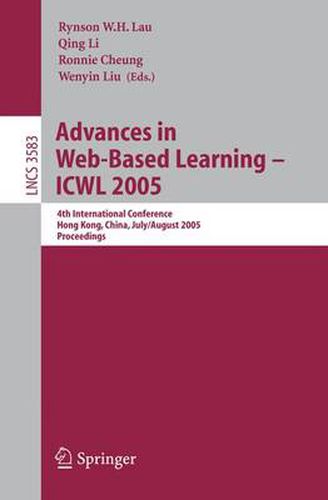Readings Newsletter
Become a Readings Member to make your shopping experience even easier.
Sign in or sign up for free!
You’re not far away from qualifying for FREE standard shipping within Australia
You’ve qualified for FREE standard shipping within Australia
The cart is loading…






This title is printed to order. This book may have been self-published. If so, we cannot guarantee the quality of the content. In the main most books will have gone through the editing process however some may not. We therefore suggest that you be aware of this before ordering this book. If in doubt check either the author or publisher’s details as we are unable to accept any returns unless they are faulty. Please contact us if you have any questions.
With the rapid development of Web-based learning, a new set of learning - vironments including virtual classrooms, virtual laboratories and virtual u- versities are being developed. These new learning environments, however, also introduce new problems that need to be addressed. On the technical side, there is a need for the deployment of e?ective technologies on Web-based education. On the learning side, the cyber mode of learning is very di?erent from tra- tional classroom-based learning. On the management side, the establishment of a cyber university imposes very di?erent requirements for the set up. ICWL 2005, the 4th International Conference on Web-Based Learning, was held in Hong Kong, China from July 31 to August 3, 2005, as a continued - tempttoaddressmanyoftheabove-mentionedissues.Followingthegreatsuccess of ICWL 2002 (Hong Kong, China), ICWL 2003 (Australia), and ICWL 2004 (China), ICWL 2005 aimed at presenting progresson the technical, pedagogical, as well as management issues of Web-based learning. The conference featured a comprehensive program, including a number of tutorials, two keynote talks, a main track containing regular as well as short paper presentations, and an application track. We received a total of 99 submissions from all over the world. The Program Committee selected 33 papers as regular papers for presentation in the main track, an acceptance rate of about 33%. Due to the high-quality submissions, the Committee decided to further accept 9 papers as short papers for presentation.
$9.00 standard shipping within Australia
FREE standard shipping within Australia for orders over $100.00
Express & International shipping calculated at checkout
This title is printed to order. This book may have been self-published. If so, we cannot guarantee the quality of the content. In the main most books will have gone through the editing process however some may not. We therefore suggest that you be aware of this before ordering this book. If in doubt check either the author or publisher’s details as we are unable to accept any returns unless they are faulty. Please contact us if you have any questions.
With the rapid development of Web-based learning, a new set of learning - vironments including virtual classrooms, virtual laboratories and virtual u- versities are being developed. These new learning environments, however, also introduce new problems that need to be addressed. On the technical side, there is a need for the deployment of e?ective technologies on Web-based education. On the learning side, the cyber mode of learning is very di?erent from tra- tional classroom-based learning. On the management side, the establishment of a cyber university imposes very di?erent requirements for the set up. ICWL 2005, the 4th International Conference on Web-Based Learning, was held in Hong Kong, China from July 31 to August 3, 2005, as a continued - tempttoaddressmanyoftheabove-mentionedissues.Followingthegreatsuccess of ICWL 2002 (Hong Kong, China), ICWL 2003 (Australia), and ICWL 2004 (China), ICWL 2005 aimed at presenting progresson the technical, pedagogical, as well as management issues of Web-based learning. The conference featured a comprehensive program, including a number of tutorials, two keynote talks, a main track containing regular as well as short paper presentations, and an application track. We received a total of 99 submissions from all over the world. The Program Committee selected 33 papers as regular papers for presentation in the main track, an acceptance rate of about 33%. Due to the high-quality submissions, the Committee decided to further accept 9 papers as short papers for presentation.